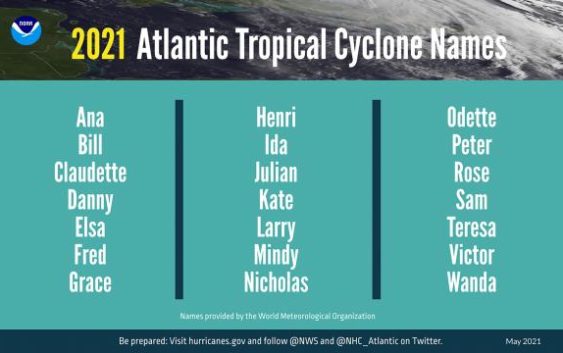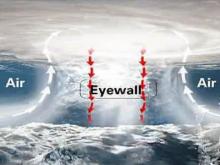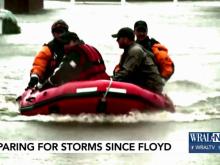- Teen thrown from home during EF-2 tornado takes first steps in ICU — with a surprise message from Shaq
- Tennessee restores 46 out of 49 roads post-Hurricane Helene
- Duke Energy boosts storm readiness with technology ahead of hurricane season
- Acting head of FEMA told staff he was previously unaware the US has a hurricane season; DHS said he was joking
- What Texas lawmakers did after the state’s largest wildfire
What you need to know about 2021 Atlantic hurricane season

The official start of hurricane season only began weeks ago, and already a tropical depression has formed off the coast of North Carolina.
With maximum sustained winds near 35mph, it is expected to become a tropical storm by Monday night.
Before the season even became, Subtropical Storm Ana formed in the Atlantic Ocean on May 21. The storm did not have much of an impact on the United States, but did increase the rip current risk along North Carolina’s coast.
There’s a chance that the system on North Carolina’s coast could be the second named storm of the season, “Bill.”
NOAA’s Climate Prediction Center has predicted another above-normal Atlantic hurricane season. Forecasters predict a 60% chance of an above-normal season, a 30% chance of a near-normal season, and a 10% chance of a below-normal season.
According to the NOAA 2021 Hurricane Forecast, we can expect: 13-20 named storms, 6-10 hurricanes, 3-5 major hurricanes.
A likely range of 13 to 20 named storms (winds of 39 mph or higher), of which 6 to 10 could become hurricanes (winds of 74 mph or higher), including 3 to 5 major hurricanes (category 3, 4 or 5; with winds of 111 mph or higher) are expected.
While the good news is experts do not anticipate the historic level of storm activity seen in 2020 — now is the time for residents in coastal regions, or areas prone to inland flooding, for rainfall to prepare for the season.
The formation of Monday’s tropical storm shows how much activity in the tropics is beginning to pick up.
Ways to prepare before a storm
Taking photos on your camera or cellphone to catalog every item in your home may seem like a hassle, but it could save you a lot of trouble if disaster strikes. Other steps to take include keeping important documents secure in a safety deposit box, backing up computer files and making sure you have adequate and up to date insurance coverage.
Consider putting together a hurricane survival kit. North Carolinians should consider creating a 3-day supply kit that includes essentials such as water bottles, water purification kits, first-aid kits, non-perishable foods and blankets.
The experiences of Hurricanes Hugo, Bertha and Fran have taught North Carolinians to be prepared to live without utilities and basic services for two weeks or more. Consider packing detergent, disposable plates, cups, utensils, lanterns and fuel amongst the items in your 14-day supply kit.
Remember: When packing, be realistic about what you can carry. Pack only what is essential for surviving the storm and its aftermath.
Staying safe with WRAL News
WRAL News has a number of ways to make sure you are prepared before and during any storm that comes near the state:
Many organizations, such as the American Red Cross, open free shelters before a storm hits. If you do go to a shelter, be sure to bring medicine, clothing and blankets with you. Keep in mind, some shelters don’t accept pets — so call beforehand.
Don’t get scammed after a storm strikes
North Carolina’s long Atlantic coast has a history of weathering and withstanding hurricanes, but high winds and storm surge can do damage even inland when the conditions are right.
If your home is impacted by flooding after a storm, FEMA has tips for the next steps:
- Beware of hazards
- File a flood insurance claim
- Clean up
After a storm strikes, beware of potential fraud. The state Department of Insurance has advice for handling insurance after a storm including being on the lookout for insurance sames from purported roofing companies traveling door-to-door telling homeowners their roof is damaged and needs repairing or in some cases to be replaced. More information on how to properly handle insurance can be found here.
A look back at historic hurricanes in North Carolina
North Carolina is no stranger to major hurricanes.
Hurricane Hazell hit the southern coast of North Carolina in October 1954, during the year’s highest lunar tide. The storm surge was a staggering 18 feet in Calabash, while winds clocked at 150 miles per hour on Holden bar. Inland, in Goldsboro and Kinston, winds were as high at 120 miles per hour.
Nineteen people died, and more than 200 people were hurt when Hazel moved across eastern North Carolina. More than 15,000 homes and other buildings were destroyed, with property losses at $136 million.
Hazel became a new point of reference for North Carolinians and created a high water mark for misery.
Hurricane Floyd struck North Carolina on Sept. 16, 1999, just 10 days after Tropical Storm Dennis dumped 6 to 16 inches of rain across the eastern part of the state.
The ground was already saturated when Floyd dumped another 12 to 20 inches of rain. Rivers overflowed their banks and floodwaters began to cover roads and inundate entire communities.
Floyd killed 52 people in North Carolina – most of whom drowned as they tried to flee to higher ground in their cars. More than 87,000 people registered with the Federal Emergency Management Agency. The floods destroyed about 8,000 homes and damaged more about 67,000. About 12,000 businesses were damaged.
The flooding caused about $6 billion in property damage and halted agricultural production in eastern North Carolina, causing more than $1 billion in farm losses. The floods killed nearly 3 million chickens and turkeys and more than 30,000 hogs.
Ten years later, many communities affected by the devastating floods still haven’t fully recovered.
In more recent years, Hurricane Florence, a large and slow-moving Category 1 hurricane, made landfall at Wrightsville Beach, N.C., on Sept. 14, 2018, bringing a record 8.27-foot storm surge.
Over the next three days, it produced up to 30 inches of rainfall over eastern North Carolina. Interstates 95 and 40 were both closed due to flooding, and 42 people died across the state.


